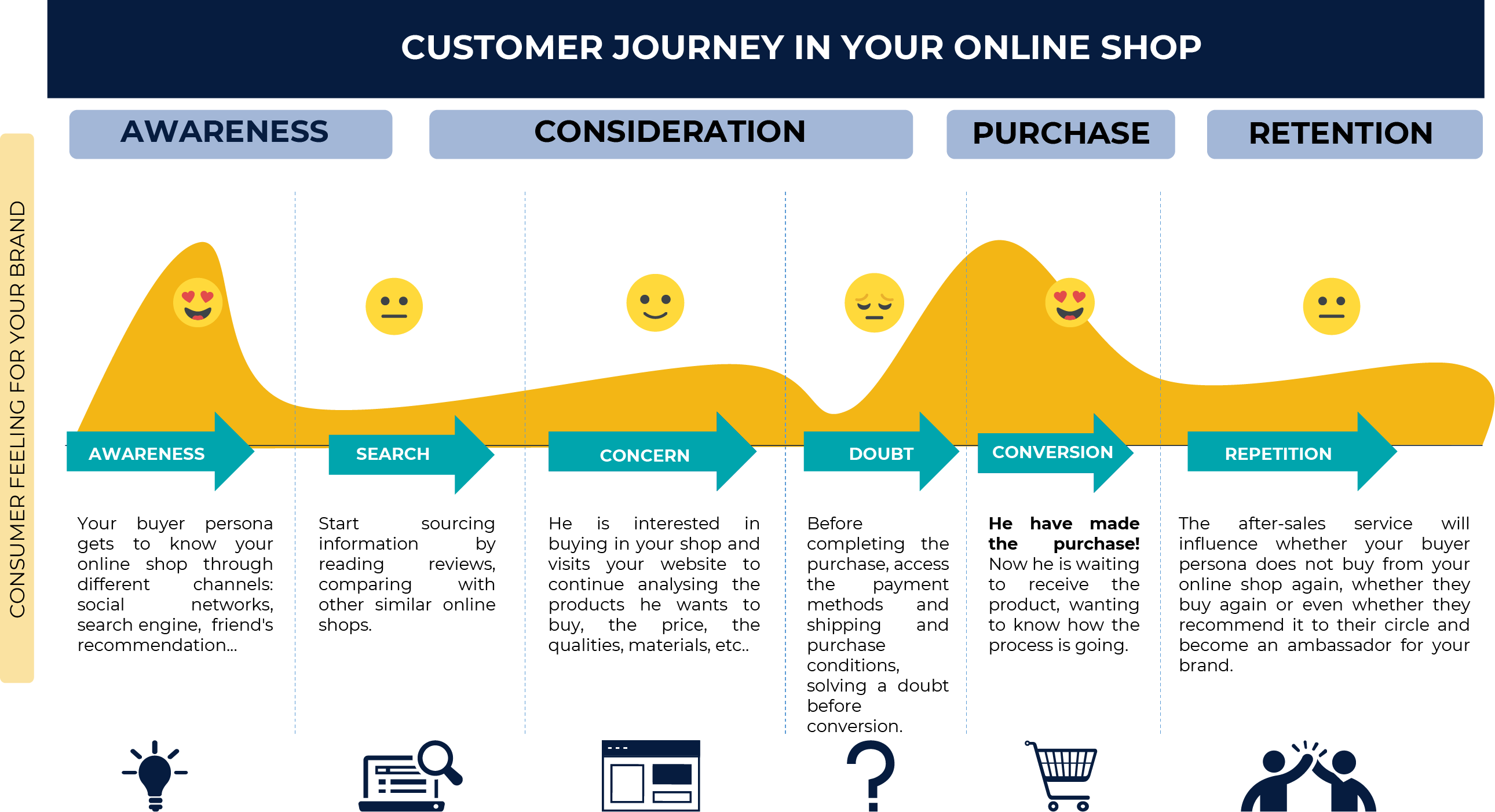What is the customer journey tool and what is it for online sales?
Outperform your customers' expectations and improve their shopping experience with the customer journey tool.

If you want to understand your customer and offer them what they need at any time, this post will be useful for you. We are going to talk about the customer journey and how it can help you improve your online business sales.
The customer journey is a tool or technique that allows companies to better understand their customers' buying process by tracking their needs at each stage of the process. This technique consists of analysing their behaviour from the moment they have a need until they become customers. This concept has been widely used in physical sales, but it is also applied to online channels, where accurate data is available in real time, allowing the customer journey to be personalised.
If you identify the needs your customer wants to satisfy, the points they come into contact with your brand and the channels they use, you can work to meet their expectations and improve their shopping experience, in many cases building customer loyalty.
5 tips for an effective customer journey for online sales.
- Personalise the customer journey for each of your buyer personas.
First, you need to identify who your buyer personas are, in other words, what characteristics your customers tend to share. In this way, you will be able to contact them in a personalised way, establishing close links that allow you to understand their needs and offer them solutions. Every purchase decision is personal, so try to have conversations with your customer to connect and understand what they are looking for.
- Offer your customer the added value they are looking for.
You need to know what value your customer is seeking at each stage of the purchase in order to provide it. For example, some customers need to read product reviews before purchasing, and others will not complete the purchase if the payment method they want is not available. Therefore, it is important to know what they expect so you can offer it to them.
- Ask your customers about their experiences.
You may have heard the phrase "people will forget what you said, they will forget what you did, but will never forget how you made them feel”, said by Maya Angelou, a well-known American writer and poet. The same is true for online sales. Don't focus on asking about specific products or services. Ask about the experience they are looking for and what they want to feel. If you can identify the underlying emotion, you will be able to connect much more with your customer.
- Apply all the information you have discovered.
Once you know your customer perfectly, you have to apply this information detected in all the phases of your customer journey that require it. In addition, the communication you carry out in all channels and phases must be homogeneous so that customers see your SME as a coherent and unified brand.
- Monitor all touch points.
Keep analysing your customers' behaviour at all touch points to detect if there have been any changes or if you need to rectify at some point. This continuous awareness will allow you to react quickly before your sales are damaged.
Example of a customer journey in your online shop.

Image 1. Customer journey in your online shop. Own production.
Your buyer persona's first contact is what determines how they became aware of you. Whether they found your online shop through social media, an internet search engine (e.g. Google, Bing, Yahoo) or a friend’s recommendation, among other options.
Your potential customer can start a search by reading reviews about your online shop, checking it against other similar shops and visiting your website to see all your products. This point of contact with the customer is very important, so the website needs to be clear, coherent and well designed.
If they have finally found what they are looking for, they will make the purchase, but before they proceed, it is likely that they will have some doubts, such as which payment methods your shop has or how long it will take to receive the order. For this reason, at this stage of the journey, it is highly recommended that you have a FAQ page or chat available as a channel to resolve any doubts.
If your customer has solved his doubts and is satisfied with the process, he will buy and access the shopping cart. They will confirm the shipping terms and the payment gateway. To complete the conversion, make sure your shipping terms are realistic, have multiple payment methods and make sure your website offers the right payment security.
Your customer is satisfied with the purchase, but don't forget about after-sales service. This last step is essential for your customer to be pleased, buy again and share their experience on social media and other channels. Loyalty is key, as it not only builds customer loyalty, but can encourage them to act as ambassadors. This is achieved through excellent after-sales service.
Therefore, it is important that you focus on your customer, their needs and expectations, and tailor your business' customer journey to meet them. In addition, it is essential to maximise the user experience at all touch points to attract more customers and increase your online sales.












